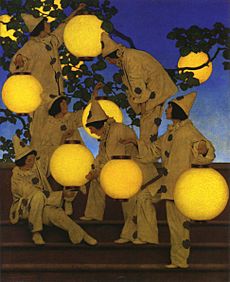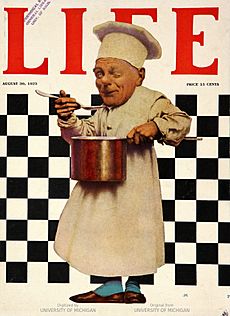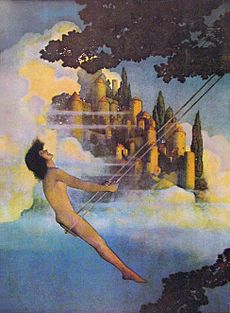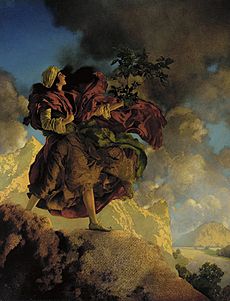Maxfield Parrish facts for kids
Maxfield Parrish (born July 25, 1870 – died March 30, 1966) was an American painter and illustrator. He was very active in the first half of the 20th century.
Parrish is famous for his bright, rich colors and dream-like, classical scenes. His career lasted for fifty years and was incredibly successful. The National Museum of American Illustration said his painting Daybreak (1922) was the most popular art print of the 20th century.
Contents
Early Life and Learning
Maxfield Parrish was born in Philadelphia, Pennsylvania. His father, Stephen Parrish, was a painter and etcher. His mother was Elizabeth Bancroft. His birth name was Frederick Parrish. Later, he started using Maxfield, which was his grandmother's last name, as his professional name.
He grew up in a Quaker family. As a child, he loved to draw for fun. His parents saw his talent and encouraged him. Between 1884 and 1886, his family took him to Europe. He visited England, Italy, and France. There, he saw many famous buildings and paintings by old masters. He also studied at a school in Paris.
Parrish went to the Haverford School. Then, for two years starting in 1888, he studied architecture at Haverford College. To learn more about art, he studied at the Pennsylvania Academy of the Fine Arts from 1892 to 1895. His teachers included Robert Vonnoh and Thomas Pollock Anshutz.
After graduating, Parrish went to Annisquam, Massachusetts. He shared a painting studio with his father there. A year later, his father encouraged him to attend the Drexel Institute of Art, Science & Industry. He studied with the famous artist Howard Pyle there.
His Art Career

Parrish's art career lasted over 50 years. He helped shape the "Golden Age of Illustration" in America. During his career, he created almost 900 pieces of art. These included calendars, greeting cards, and magazine covers. His early works were mostly in black and white.
In 1895, his art was featured on the Easter edition of Harper's Bazaar magazine. He also worked for other magazines like Scribner's Magazine. One of his posters for The Century Magazine was even shown in a famous French art collection called Les Maîtres de l'Affiche. In 1897, he illustrated a children's book called Mother Goose in Prose, written by L. Frank Baum. By 1900, Parrish was already a member of the Society of American Artists. In 1903, he traveled to Italy again.
Parrish took on many jobs for commercial art until the 1920s. His commercial art included important projects. He illustrated Eugene Field's Poems of Childhood in 1904. He also worked on classic stories like Arabian Nights in 1909. Other books he illustrated include A Wonder Book and Tanglewood Tales (1910), The Golden Treasury of Songs and Lyrics (1911), and The Knave of Hearts (1925).
By 1910, Parrish was earning a lot of money from his art.
In 1910, Parrish was asked to create 18 large paintings for the Girls Dining Room in the Curtis Publishing Company building in Philadelphia. This huge project took him six years to finish. In 1914, before these paintings were done, Curtis asked him to design a very large mural for the building's lobby. This mural, called The Dream Garden, was made of glass mosaic by Tiffany Studios. It is now part of the Pennsylvania Academy of the Fine Arts collection.
Parrish worked with popular magazines throughout the 1910s and 1920s. These included Hearst's and Life. He also created advertisements for companies like Wanamaker's, Edison-Mazda Lamps, Colgate, and Oneida Cutlery. He worked with Collier's magazine from 1904 to 1913. He had a special contract to work only with them for six years.
He also painted advertisements for D.M. Ferry Seed Company in 1916 and 1923. These helped him become very well-known to the public. His most famous artwork is Daybreak, created in 1923. It shows female figures in a beautiful landscape. The painting also features a special shade of blue, often called "Parrish blue." In the 1920s, Parrish started to focus more on painting landscapes instead of illustrations.
When he was in his forties, Parrish began working on large murals. He earned money from posters and calendars that featured his art. From 1904, Susan Lewin (1889-1978) posed for many of his works. She also became his long-time assistant. From 1918 to 1934, Parrish created calendar illustrations for General Electric.
In 1931, Parrish told the Associated Press, "I'm done with girls on rocks." He decided to focus only on landscapes. By 1935, he painted only landscapes. While these were not as popular as his earlier works, he still made money from them. He often built small models of the imaginary landscapes he wanted to paint. He would use different lighting on them. Then he would choose the best view and photograph it. He used these photos as a guide for his paintings.
He lived in Plainfield, New Hampshire, near the Cornish Art Colony. He continued to paint until he was 91 years old. He also loved working with machines. He often called himself "a mechanic who loved to paint."
His Painting Style

Parrish's art is known for its bright, strong colors. A specific shade of blue, Parrish blue, was even named after him. He made his colors so bright by using a technique called glazing. This means he applied many thin, see-through layers of paint and oil over a base drawing. Parrish usually started with a blue and white base layer.
His paintings created a fantasy world that looked very real and was loved by many. The special blue color he used for skies is rarely seen in real life. Creating this effect was not easy. He developed a time-consuming process. He used a cobalt blue base with a white undercoat. Then, he added many thin, see-through layers of oil and varnish. When seen under ultraviolet light, the special resins he used glow yellow-green. This gives his painted skies their unique turquoise color.
Parrish used other new techniques in his paintings. He would take black and white photos of models wearing geometric patterns. Then, he would project these images onto his artwork. This helped him paint figures with accurate clothing folds and patterns. Parrish also created his paintings by taking photos of objects. He would enlarge or project these images. Then he would cut them out and place them on his canvas. He would cover them with clear glaze. Parrish's techniques made his paintings look more three-dimensional.
The way Parrish arranged his paintings was carefully planned. He used geometric rules like root rectangles and the golden ratio. He was influenced by Jay Hambidge's ideas about "Dynamic Symmetry."
Cultural Impact
Parrish's art still influences pop culture today. For example, the cover of the 1985 Bloom County cartoon book, Penguin Dreams and Stranger Things, uses parts of Parrish's Daybreak and other paintings. The poster for the movie The Princess Bride was inspired by Daybreak. In 2001, the United States Post Office honored Parrish with a special stamp.
In 1986, a TV commercial for Nestle's Alpine White chocolate bar, called "Sweet Dreams," showed live-action versions of Parrish's paintings. These included Ecstasy, Dinky Bird, and Daybreak.
The Elton John album Caribou has a background inspired by Parrish. The Moody Blues album The Present uses a version of Parrish's Daybreak for its cover. In 1984, the band Dali's Car used Daybreak as the cover art for their album The Waking Hour. The Irish musician Enya has also been inspired by Parrish's works. The cover art for her 1995 album The Memory of Trees is based on his painting The Young King of the Black Isles. Some of her music videos, like "Caribbean Blue", also show Parrish-like images.
The original painting of Daybreak sold for US$7.6 million in 2006. The National Museum of American Illustration has the largest collection of his work. It includes 69 pieces, such as the 18-panel mural for the Curtis Publishing Company. Some of his works are also at the Hood Museum of Art in Hanover, New Hampshire, and a few at the Metropolitan Museum of Art in New York. The San Diego Museum of Art organized a traveling collection of his work in 2005.
The famous American painter Norman Rockwell called Parrish "my idol."
Personal Life
While studying at Drexel, Parrish met Lydia Ambler Austin, who was a drawing teacher. They married on June 1, 1895, and moved to Philadelphia. They had four children together. In 1898, Parrish moved his family to Cornish, New Hampshire. He built a home there that was nicknamed "The Oaks." The house and his studio were surrounded by beautiful landscapes that inspired his art.
Parrish had tuberculosis for a time in 1900. While he was sick, he learned how to mix oils and glazes to create his bright colors. From 1900 to 1902, Parrish painted in Saranac Lake, New York, and Castle Hot Springs, Arizona, to get better.
Parrish's youngest child, Jean, posed for his painting Ecstasy. Jean was the only one of his children to become an artist like her parents.
Later in life, Parrish developed arthritis. He took his last art job in the late 1950s. By 1960, his arthritis stopped him from painting. He spent his last years in a wheelchair. Maxfield Parrish died on March 30, 1966, in Plainfield, New Hampshire, at the age of 95.
Works by Maxfield Parrish
Books He Illustrated
- Baum, L. F. – Mother Goose in Prose, 1897
- Grahame, K. – The Golden Age, 1900
- Irving, W. – Knickerbocker's History of New York, 1900
- Grahame, K. – Dream Days, 1902
- Field, E. – Poems of Childhood, 1904
- Wharton, E. – Italian Villas and their Gardens, 1904
- Wiggin, K. D. – The Arabian Nights, 1909
- Hawthorne, N. – A Wonder Book and Tanglewood Tales, 1910
- Palgrave, F. T. – The Golden Treasury, 1911
- Saunders, L. – The Knave of Hearts, 1925
Murals He Painted
- "Old King Cole" – St. Regis Hotel, New York, 1906
- "Pied Piper" – Palace Hotel, San Francisco, 1909
Images for kids
See also
 In Spanish: Maxfield Parrish para niños
In Spanish: Maxfield Parrish para niños






